REBECCA RENNIE BIG BOARD: SMALL SCHOOL 150 (Page 4)
By Rebecca Rennie
As with every draft class, there is exceptional talent to be found outside the FBS. This presents my Top 150 of those small school prospects. Whether used pre-draft or after your team has picked up one or more of these players during or after the draft, I hope this provides some useful information or reference.
The first five pages provide profiles on the Top 50 small school prospects. Page 6 contains brief notes on the next 25. The final page contains the full Top 150 Big Board as a list.
There are a lot of players on this big board, many of whom will appear lower down on the list. I fully believe though, that with the right opportunity, every player included has the potential to be a successful pro.
In fact, there are countless other prospects that I know I will have missed. Unfortunately, this was a one-person operation without a full scouting team to hand. I’ve tried to get to as many players as possible, but had to get this posted eventually.
All draft boards are subjective and will have it’s share of misses along with hits. That’s part of the fun though, it would be dull if everyone was working off an identical board! Thanks for taking the time to look and enjoy the 2020 NFL Draft.
Note: HPFA = High Priority Free Agent Grade.
31. Gavin Heslop, CB, Stony Brook. Grade: 7th-HPFA
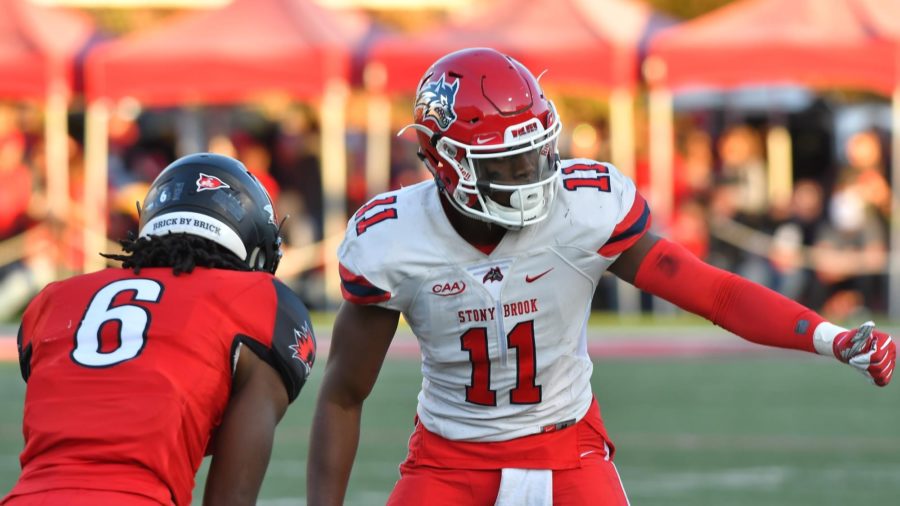
Height: 6’0”. Weight: 197lbs.
Pros: A long corner with smooth movement, Heslop has intriguing tools to work with. He’s far from explosive but is efficient with nice footwork and little wasted motion to compensate for the modest burst. While not the most fluid in his transitions, his ability to redirect is better than expected. After a positive pro day workout (one of the few schools to complete theirs in the first week), his 6.88 3-cone time particularly stood out. That, along with a nice 4.13 shuttle time, reflect his clean footwork.
Experienced at the FCS level, Heslop started all 37 games over his final 3 seasons. His good general instincts pair well with that significant playing time to provide a consistent product on the field. He uses his length at the catch point, tracking the ball and timing his vertical well. The Stony Brook corner fights for position over the course of routes and as the ball arrives. Playing up to his size, physicality is present in all aspects of his game. Given his relative lack of burst, that proactive style of play could come in handy if asked to play more of a safety role inside.
Cons: While his 4.57 pro day time was solid, the favourable conditions of the home field setting may have helped keep him under 4.6 seconds. On film there is solid speed but a relative lack of quickness that is somewhat negated by the previously referenced efficient footwork. There are examples though of struggling to recover on some situations where Heslop is beaten early in the route. If the Seawolves DB isn’t able to disrupt his receiver early from press with his hands, he can be left trailing at times.
Wrapping Up: Those who covet size and length could look to Heslop as an intriguing flier in the later rounds. There’s potential to find a home at corner or potentially to try him at safety, giving him added value toward the back end of the roster initially while he develops. The combination of his frame, footwork, instincts and versatility make him a worthy choice late in the draft. NFL Comparison: Pierre Desir.
32. Myron Morris, CB, Wagner. Grade: 7th-HPFA
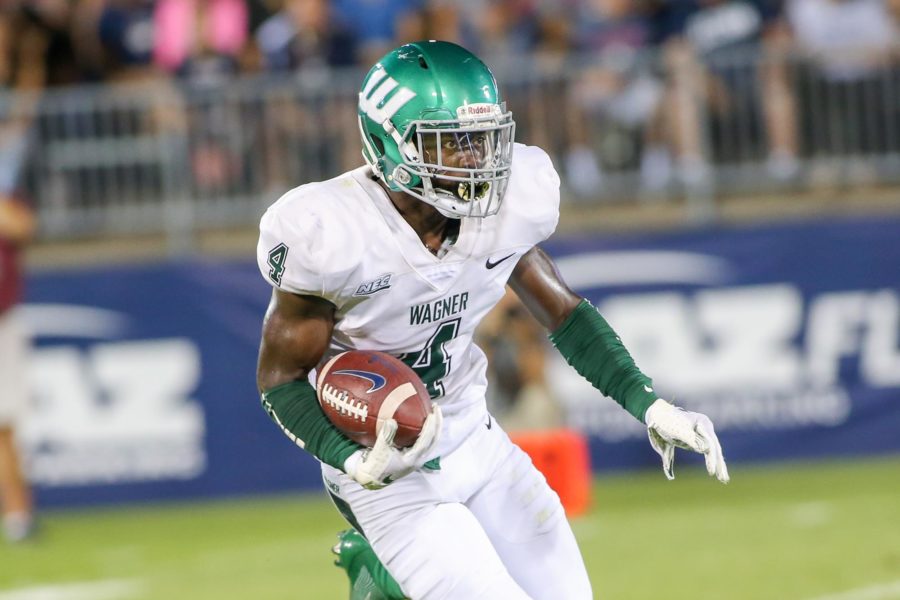
Height: 5’11”. Weight: 177lbs.
Pros: Don’t be surprised if the Wagner Seahawks are mentioned several times over draft weekend. In addition to DL Chris Williams and do-everything LB/EDGE Cam Gill, Myron Morris has a chance himself to be a part of the 3-day event. Impressive pro day results should have sent plenty back to the film to get a closer look. Morris’ numbers including a 4.47 dash, 10-6 broad jump and 7.07 3-cone time. The short-area quickness, fluidity and top-end speed clearly stand out on film. His quick feet aid him in his easy transitions and redirecting to click-and-close on comeback routes. The overall range allows him to cover from short to deep and across the width of the field.
Morris regularly looks fantastic in man coverage, staying tight and in phase, mirroring receivers smoothly and effectively. The anticipation and reactions are there to maintain position at the top of routes. There are plenty flashes of good vision and positional IQ, including in his recognition and understanding of his assignments in zone coverage assignments to pick up potential targets entering his area of responsibility.
Utilizing a well-drilled slide step technique in zone, he shows good eye discipline between the QB and receiver. While not quite as accomplished from press, he uses his hands initially and transitions smoothly to turn and run. While not piling up pass breakups and interceptions, Morris makes nice adjustments at the catch point to make plays on the ball when the opportunities are there. In many games he’s simply not targeted often due to tight coverage. His experience at kick returner provides added value.
Cons: He won’t back down from a challenge, but Morris isn’t the most physically imposing of corners, including featuring a relatively slighter, leaner frame. There’s the potential for bigger bodied receivers in the pros to take advantage when working for favourable position downfield and at the catch point. Run support is also not an area of notable strength, tending more to use finesse to ride ball carriers out of bounds and not lay all out to make solo tackles consistently. Don’t mistake that for any lack of fire however, playing with plenty edge and competitiveness.
Wrapping Up: Morris is a blast to watch on film with natural coverage skills and ideal athletic traits to hold up at the NFL level. Special teams value could give him an edge over other potential late rounders and free agents, and has the potential to surprise many as a training camp standout in the right fit. NFL Comparison: Parry Nickerson.
33. Manasseh Bailey, WR, Morgan State. Grade: 7th-HPFA
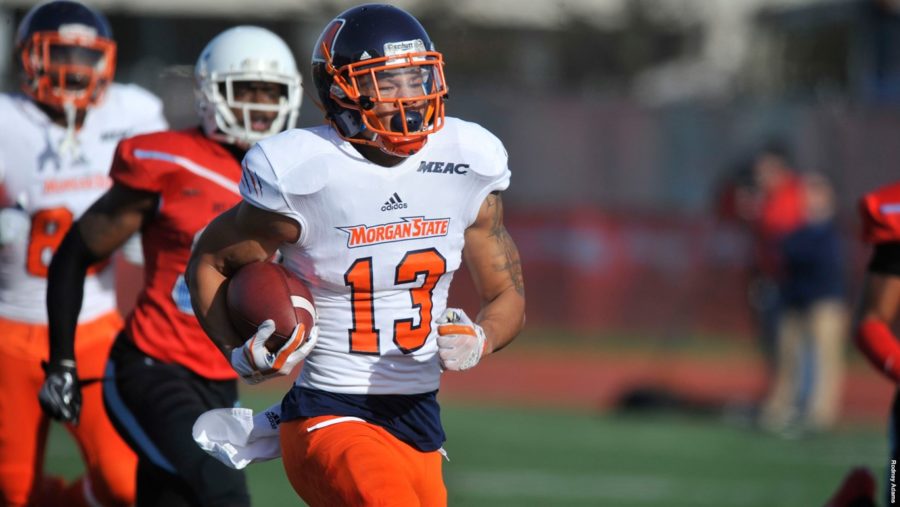
Height: 5’11. Weight: 189lbs.
Pros: A smaller receiver, Bailey is a plus athlete with the potential to find a role as a deep threat in the pros. The Morgan State receiver put together some of his best performances against top opposition faced in 2019. He torched Army for a pair of touchdowns, in addition to producing well against James Madison, perhaps the most talented defense in the FCS this past year.
With not only good acceleration out of his stance, the Bears receiver has suddenness in his changes of direction and at the top of his routes to buy a step or two of separation. His quick feet and ability to work himself open could fit well working from the slot on a regular basis, with after-the-catch ability to add to his threat level. Bailey flashes proactive use of his hands to deflect contact. He will also offer some shake in the initial phase of his routes to flat-foot cornerbacks.
Continuously working, the Morgan State receiver will keep battling to get open for his QB on broken plays. Tracking the ball well, he comfortably adjusts to the football as it arrives, and regularly shows off soft natural hands. His athleticism could see him find a role on special teams units, crucial for his chances of making a roster. He made an impact there this season, blocking multiple punts.
Cons: Bailey has a small and slight frame, lacking in length. He could be more consistent with his handling of aggressive defensive backs, who have shown the ability to disrupt his routes with physical coverage. While he flashes hand use, Bailey could work his hands more consistently to prevent some of the disruption he’ll face in press and over the course of routes.
Not invited to the Combine or any of the major All-Star events, he instead took part in the Tropical Bowl. He did stand out there, however, including a nice touchdown play in the game to close out the week. Putting up good numbers at his pro day will be critical to his pro chances. If he fails to do so, his chances become longer.
Wrapping Up: There’s been very little buzz around Bailey that might indicate there’s not a great deal of interest from teams. The film is intriguing though, flashing well as a deep threat. If he lands in the right situation, he could find a role as a situational contributor and special teamer. NFL Comparison: Shelton Gibson.
34. Devin Cates, TE, Drake. Grade: 7th-HPFA
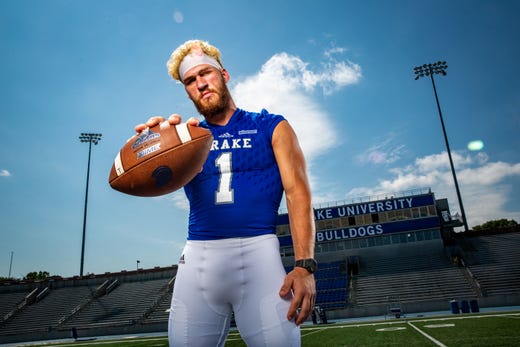
Height: 6’4. Weight: 255lbs.
Pros: As an excellent athlete with impressive receiving skills, Cates has upside to work with. Though not an official pro day, Cates’ recent workout included some impressive marks to offer an indication of his physical abilities. Those traits are observable on game film. Cates releases off the line well with good upfield burst, accelerating to top speed quickly. He consistently maintains his speed as he changes directions.
There’s an overall fluidity to his movements, both as he redirects and adjusts to the ball. His natural receiving skills include a good vertical and timing with his hands and jumps to high point. Cates shows soft hands to claim the ball out of the air. Nothing looks forced or uncomfortable in his process and execution as a receiver. Though a better receiver than blocker, there’s great effort in run support. His agility aids him in executing his blocks in space.
Cons: Though certainly not undersized, Cates is relatively smaller for the position. That might somewhat limit his potential usage and upside in certain schemes. He has previously been suggested as a potential projection to more of an H-back role. As mentioned above, there’s room to improve in his blocking. He is solid in this area at the FCS level but will of course see more challenging matchups at the pro level. Continued work on his technique and strength at the point of attack will be of benefit.
Wrapping Up: Being named as 2019 first team All-Pioneer League at receiver says plenty about Cates’ impact as a pass catcher. His 51 receptions for 627 yards and 9 touchdowns concluded a superb collegiate career in which the Tight End prospects showed progress and increased influence each season. With his smooth movement and receiving abilities, there’s the potential to prove a bargain late or undrafted. NFL Comparison: Jacob Hollister.
35. Bill Murray, DL, William & Mary. Grade: HPFA
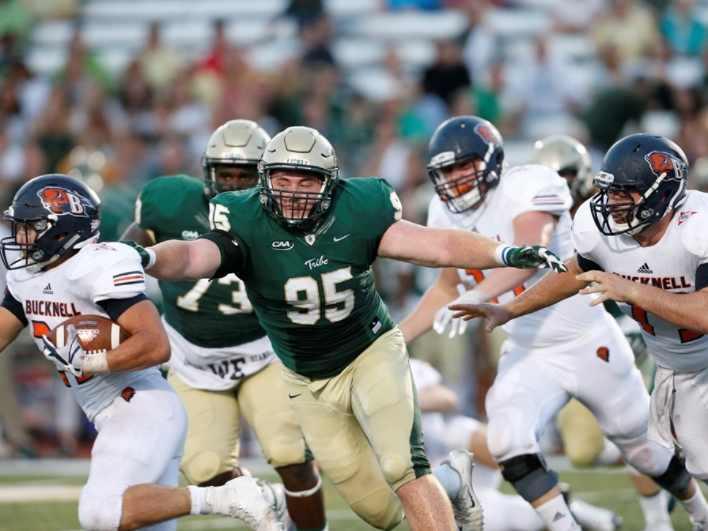
Height: 6’4. Weight: 300lbs.
Pros: With many fringe prospects putting out unofficial workouts to try and catch the attention of the NFL, Murray was able to get something more legitimate on record early on. Part of the TEST Football Academy pro day event, Murray got more concrete testing completed, including laser timing. His numbers included an impressive 4.93 dash (1.61 split), 32.5” vertical, 9-4 broad and 30 reps on the bench. He’s reportedly gotten leaner and more athletic in his movements even since the start of the 2019 season.
The combination of size and strength are the primary appealing traits for the next level. Murray has a broad frame with good length. His big hands deliver an impactful punch with good extension into contact. His well-placed hands and core strength combine to knock O-linemen off balance and create good push to close the pocket. When able to leverage well, Murray shows disruptive qualities and potential to threaten the QB from the interior. There are good reactions off the snap, aggressive intent and a strong motor. The latter shows up in his pursuit, chasing down ball carriers to the sidelines.
Cons: Murray can prove inconsistent in applying himself at the point of attack. What’s quickly notable in his film is a tendency to jump upright often out of his stance. The Tribe defensive lineman can get overly narrow in his base with poor pad level. While his natural power minimizes the issues, he can negate one of his key advantages and will be more notable at the NFL level. While there’s some potential as an interior pass rusher, there’s rawness in his rush plans. Murray requires more polished upper body technique and execution of rush moves.
Wrapping Up: Though playing at a lower level, Murray stood out often in a key matchup with Virginia early in his senior season. Moving well at that time, he’s reportedly toned his physique further at this time. The Gridiron Showcase attendee has had a positive pre-draft process. There’s developmental potential should he sharpen up some technical inconsistencies. NFL Comparison: Hassan Ridgeway.
36. Broc Rutter, QB, North Central (IL). Grade: HPFA
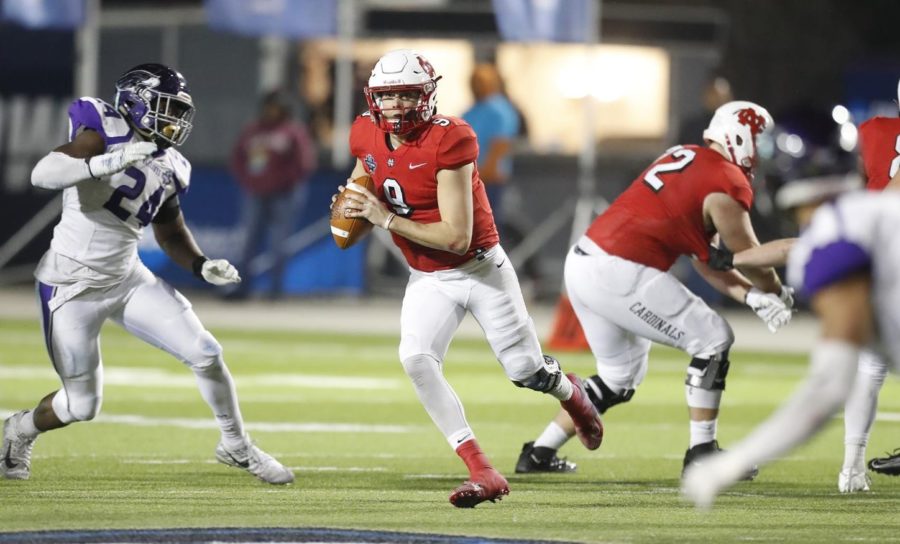
Height: 6’2”. Weight: 204lbs.
Pros: Though doing so at the Division 3 level, Rutter has a ton of experience. Over his four seasons he started all 51 games for the Cardinals. He finished strongly, leading North Central to their first National title win and winning the Gagliardi Award given to the most outstanding player at the D3 level. Dominating the competition, his production has been ridiculous, regardless of level. In 2019, Rutter completed 71% of passes for 4591 yards, 56 TDs and only 5 interceptions.
What most appeals about Rutter is his exceptional feel for the position, poise in the pocket and decision making. He’s a savvy passer with impressive touch on his throws and fantastic accuracy. The Cardinals QB gets into rhythms at times where he seemingly can’t miss. There’s a presence to him in the pocket, excelling in his understanding of the offense. He executes with calmness, confidence and composure. Though not a standout athlete, he makes some smart decisions when tucking the ball to run.
The throwing mechanics are relatively lengthy but with a quick motion and release. Stepping into his throws smoothly, his passes leave the hand cleanly with a consistent spiral that contributes to his reliable ball placement. Rutter shows impressive anticipation and timing on his throws, both on shorter passes and deeper down the field. At the Hula Bowl All-Star event, Rutter had an outstanding 2-minute drill to close the half with a touchdown, showing his signature poise to attending scouts.
Cons: While not concerningly deficient in any area, Rutter has modest physical measurables at best. Arm strength is sufficient with nice zip on his passes but won’t be described as owning a rocket arm. Though most teams aren’t as stubborn on stature anymore, Rutter has a relatively smaller frame. He can move effectively and make some plays with his legs but won’t scare defenses as an athlete when the play breaks down.
Wrapping Up: There’s a significant step up in level required but the gut feeling is that Broc Rutter has what it takes. The mental side of the game looks complete, with instincts, feel and poise. He sees the field well, works through his progressions and makes good decisions. His technique as a passer is textbook and shows accuracy and touch better than many bigger name prospects. Rutter may go undrafted but could surprise in camp in the right situation and fit.
37. Zach Larsen, IOL, Southern Utah
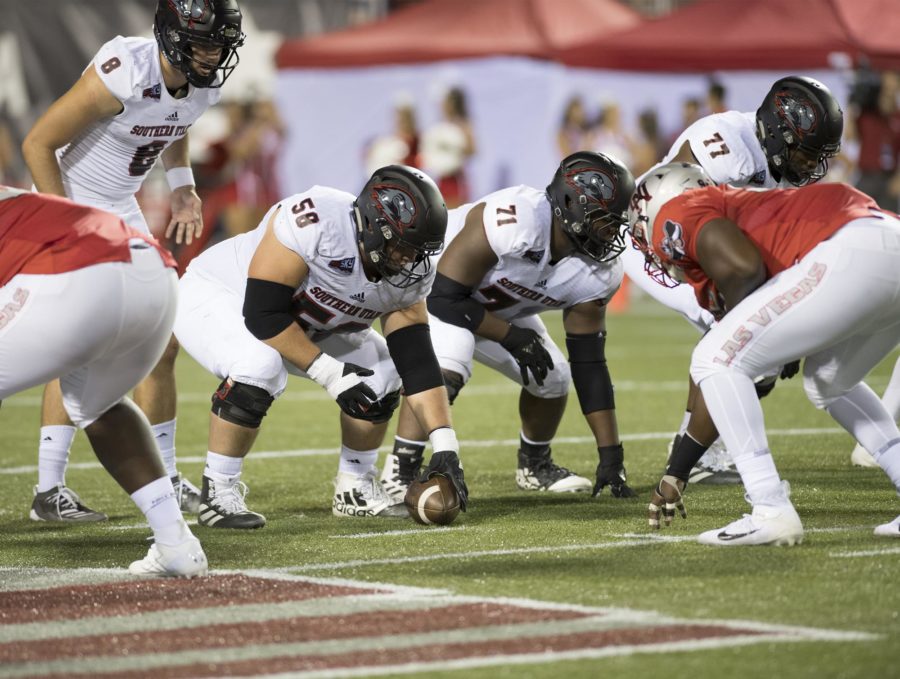
Height: 6’1”. Weight: 312lbs.
Pros: Prepare for a battle each and every snap when lining up opposite Larsen. Tenacious and tough as heck, Larsen thrives at the point of attack once established on blocks. In pass protection, he takes full advantage of his stout base, core strength to anchor and natural leverage. Larsen consistently holds his ground as a result, proving difficult to work backward off his spot and into the pocket, despite a reach disadvantage.
The Southern Utah lineman brings a relentless motor to the table. Larsen drives his legs and finishes through the whistle. He consistently executes on combination blocks and steps up well onto the second level as a run blocker. He is always on the hunt for an additional defender to block when free in space. Larsen is technically sound and coordinated between his upper and lower body. The low center of gravity helps in his balance and form.
Cons: Should Larsen go undrafted, the measurables will be the likely primary reason. Frankly, the Thunderbirds center is not going to be on the board for many teams. In addition to the shorter frame, Larsen measured in with just 32 1/8” arms and 75 ¾ wingspan. While effective at the point of attack once locked on, there are times when length is an unavoidable disadvantage. D-lineman able to exploit their reach advantage will win a share of the reps.
Wrapping Up: While length will hurt his draft stock, don’t bet against Zach Larsen working his way to a roster spot. With all the intangibles to overachieve, he maximizes his abilities through technique, toughness and leverage. Smart play, recognition and strength has seen the likes of Patriots center David Andrews thrive in the pros. Larsen has every chance to do replicate that success. NFL Comparison: David Andrews.
38. Bronson Rechsteiner, FB, Kennesaw State. Grade: HPFA
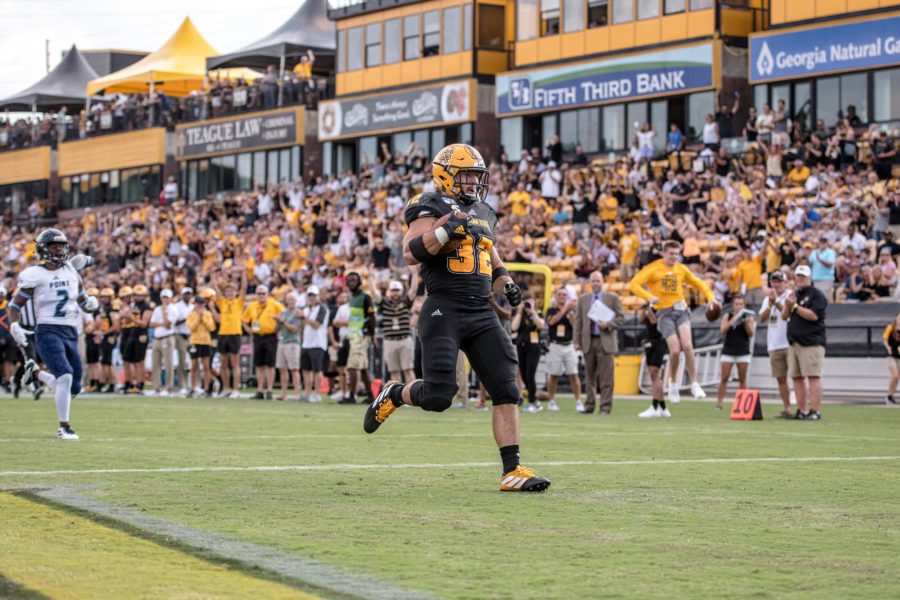
Height: 5’11”. Weight: 230lbs.
Pros: Rechsteiner consistently stood out as a playmaker and athlete on film as a senior. The latter was emphatically confirmed at his pro day. The ripped full back recorded a 4.48 dash with speed that shows up on game film. He added a 35.5” vertical, 10-0 broad, 6.95 cone and 4.22 shuttle. His obvious power was reflected in his 35 bench reps. Seeing plenty of action within the Owls’ triple option attack, Rechsteiner will offer more to his projected full back role than just as a blocker. He adds value as a receiver and ball carrier.
Once free on the open field, Rechsteiner is a truck that is challenging to stop once at top speed. The agility and burst at his size stand out, with impressive suddenness in his changes of direction. The physicality as a blocker is propped up by good balance and leverage in his technique to go with the core strength. He’s proven to be a reliable receiver out of the backfield when asked, though with minimal targets in the primarily ground-based offense. Rechsteiner totalled 909 rushing yards at 8.12 yards a carry and 7 touchdowns as a senior.
Cons: He could be looking to pursue a career in pro wrestling. Some NFL personnel might view that negatively. The son of wrestler Rick Steiner has reportedly wanted to follow in the footsteps of his father and Uncle Scott. The willingness to grind at the bottom end of a roster for several seasons when there are alternative opportunities might be a consideration. An NFL opportunity could delay that possibility for now. He seems the type who will be committedly fully to whichever path he chooses.
Wrapping Up: There’s a lot of great highlight videos out there but Rechsteiner’s might be the best of the lot. Be sure to check that out at the very least. The Owls playmaker is rocked up, explosive, dynamic and versatile. He has the potential to be one of the more impactful playmakers from the full back position if utilized fully. NFL Comparison: Marcel Reece.
39. Michael Hoecht, DL, Brown. Grade: HPFA
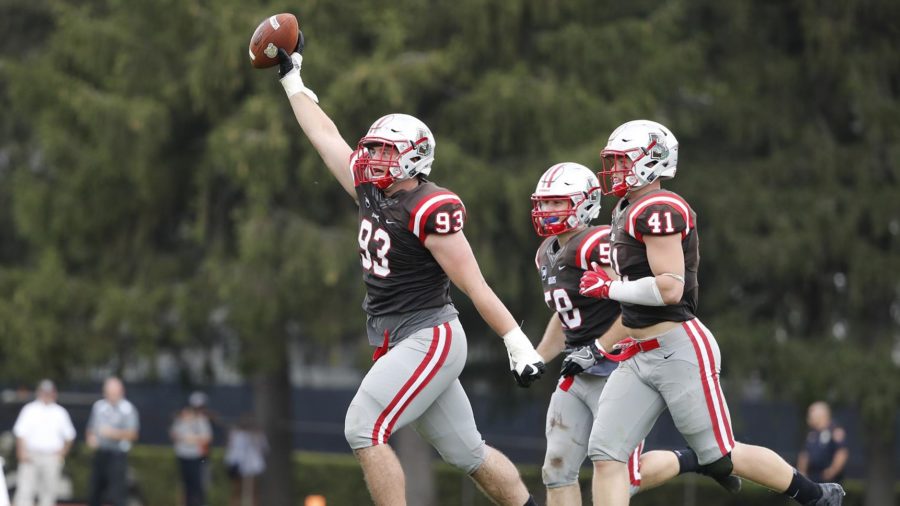
Height: 6’3”. Weight: 290lbs.
Pros: With a solid combination of size and athleticism, Hoecht doesn’t have any one elite trait but does everything competently with a well-rounded physical skill set. The Brown senior has nice quickness from his stance, aiding his initial upfield burst through good reactions off the snap. He brings energy to every rep with a high motor. His unofficial testing suggested a very good athlete, including an exceptional 4.65 dash if accurate.
Often making use of an effective swim move, he has positive upper body technique and quick powerful hands. Whether getting effective extension into the chest of opposing lineman, or evading contact with his rush moves, his technical refinement could translate to continuing to get interior pressure in the pros. His well-timed push-pull technique also sees good results as he works against a single blocker. At the FCS level, Hoecht held up well at the point of attack, proving tough to move off his spot. Fellow Ivy League standout Zach Sammartino cited Hoecht as the best player he faced.
Cons: While he flashes disruption, there are a lot of 1-on-1 stalemates on film as well. He did see double team attention but didn’t always consistently dominate, with tougher challenges ahead in the pros. The traits matter more than the stats, and the production was solid, but didn’t pile up the numbers statistically. Overall though, these are minor notes, with no glaring issues in Hoecht’s game.
Wrapping Up: Many small school prospects have done what they can in unofficial pro day scenarios. Hoecht’s put his name out there after a strong senior campaign that saw him a part of The Touchdown’s Ivy League feature earlier in the season. The Brown defensive lineman has a favourable combination of size, length and athleticism that should see him contend for a roster spot. He could be a developmental candidate for the practice squad at the very least. NFL Comparison: Adam Gotsis.
40. Shane Leatherbury, WR, Towson. Grade: HPFA
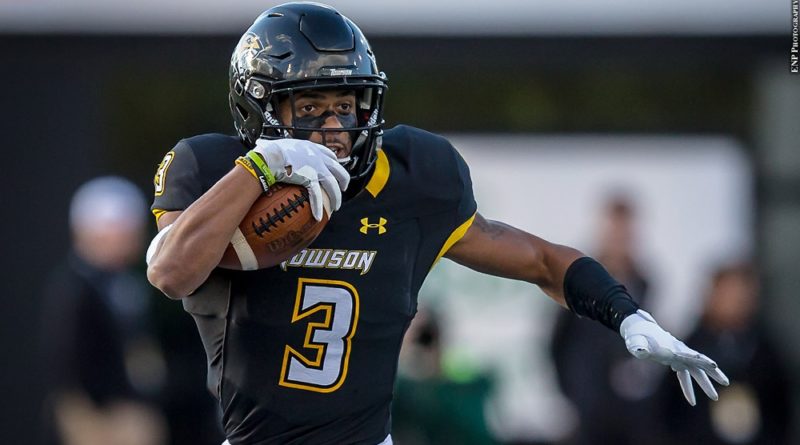
Height: 5’10”. Weight: 190lbs.
Pros: Leatherbury was another prospect fortunate enough to be a part of the TEST Football Academy pro day event. He blazed through a laser-timed 4.42 dash and posted an outstanding 40.5” vertical jump. The Towson playmaker is one of the more polished and natural receivers in a deep group among small school pass catchers. There’s an instinctive awareness and feel for positioning and space. He helped himself by flashing well in a big matchup against the Florida Gators. His senior year included 13 total touchdowns.
Leatherbury demonstrates clean releases and is quickly up to speed with nice acceleration. A smooth runner, he’s fluid in his breaks, maintaining speed to gain a step from coverage. Where he truly stands out is tracking the ball on deeper targets, excelling at bringing in passes dropped over the shoulder. The Tigers receiver has consistent hands, catches in stride with ease, adjusting to the ball beautifully. Though small, he’s an aggressive blocker to do what he can. After the catch, Leatherbury brings a running back mindset.
Cons: The smaller frame is worth noting, even though Leatherbury wins with his athletic traits and his vertical negates issues against taller corners at the catch point. The 667 receiving yards as a senior doesn’t leap off the page as dominant at the lower levels. He clearly has the skillset for the pros, so that shouldn’t be a concern.
Wrapping Up: This draft class is widely regarded as being exceedingly deep at the wide receiver position. That expands to a sea of small school receiver prospects looking for opportunities. At least in terms of media attention, Leatherbury feels under-valued. Hopefully that’s not the case with NFL decision makers. There’s a complete skill set in terms of both athleticism, natural receiving skills and application of those abilities on film.
CLICK THE LINKS BELOW TO NAVIGATE THE REST OF THE SMALL SCHOOL BIG BOARD!
PAGE 7: Top 150 Full Big Board
Feature Image Credit: Jim Harrison / Stony Brook Athletics

